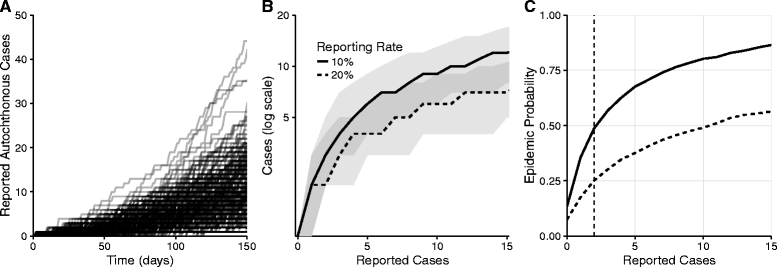Assessing real-time Zika risk in the United States
- PMID: 28468671
- PMCID: PMC5415743
- DOI: 10.1186/s12879-017-2394-9
Assessing real-time Zika risk in the United States
Abstract
Background: Confirmed local transmission of Zika Virus (ZIKV) in Texas and Florida have heightened the need for early and accurate indicators of self-sustaining transmission in high risk areas across the southern United States. Given ZIKV's low reporting rates and the geographic variability in suitable conditions, a cluster of reported cases may reflect diverse scenarios, ranging from independent introductions to a self-sustaining local epidemic.
Methods: We present a quantitative framework for real-time ZIKV risk assessment that captures uncertainty in case reporting, importations, and vector-human transmission dynamics.
Results: We assessed county-level risk throughout Texas, as of summer 2016, and found that importation risk was concentrated in large metropolitan regions, while sustained ZIKV transmission risk is concentrated in the southeastern counties including the Houston metropolitan region and the Texas-Mexico border (where the sole autochthonous cases have occurred in 2016). We found that counties most likely to detect cases are not necessarily the most likely to experience epidemics, and used our framework to identify triggers to signal the start of an epidemic based on a policymakers propensity for risk.
Conclusions: This framework can inform the strategic timing and spatial allocation of public health resources to combat ZIKV throughout the US, and highlights the need to develop methods to obtain reliable estimates of key epidemiological parameters.
Keywords: Autochthonous transmission risk; Importation risk; ZIKV; Zika.
Figures




References
-
- Gulland A. Zika virus is a global public health emergency, declares WHO. BMJ Publishing Group Ltd. 2016;352:i657. - PubMed
-
- Zhang Q, Sun K, Chinazzi M, Pastore-Piontti A, Dean NE, Rojas DP, et al. Projected spread of Zika virus in the Americas. bioRxiv. 2016.
-
- Estimated range of Aedes aegypti and Aedes albopictus in the United States, 2016. In: Atlanta: Centers for Disease Control and Prevention [Internet]. [cited 1 Jan 2016]. Available: http://www.cdc.gov/zika/vector/range.html
-
- Florida Department of Health. Department of Health Daily Zika Update [Internet]. Available: http://www.floridahealth.gov/newsroom/2017/01/012717-zika-update.html
-
- Texas Department of State Health and Human Services. Zika in Texas [Internet]. 2016. Available: http://www.texaszika.org/.
MeSH terms
Grants and funding
LinkOut - more resources
Full Text Sources
Other Literature Sources
Medical

